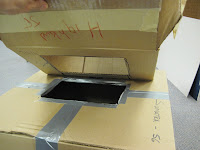Dinosaur play can be boisterous. What's appealing about this clip is that it shows girls want to be and can be boisterous, too. There is something to be said for a productive outlet for this type of play for both boys and girls.
Not all play is boisterous, though. Take a look at this clip of Alex at the Dinosaur Mountain.
You saw the first set of actions by Alex. He scoops up some bedding in his cup. It is overflowing, so he shakes it gently to level off the cup. Where did he learn that gentle shake to top of his cup? He goes around to the other end of the table, steps up on the stool, and dumps the bedding on the corner of the Dinosaur Mountain. Now what do you think he will do next? Notice he has a dinosaur in his right hand.
Did you guess what he was going to do? I did not. That is why I followed him. He did it several times, which gave me the chance to follow him. All his actions looked planned and purposeful. First he would transport the animal bedding with his cup; dump the contents on the corner of the apparatus; and then use the dinosaur to scatter the pile. Why does he transport the bedding from basically one end of the table to the other? He could have just got animal bedding from a closer point. Maybe there is something about physically moving in and around objects and obstacles that motivates a child to action. After piling the bedding, why does the dinosaur knock it down? Is that what dinosaurs do? Did you see his face? It was like he was in dinosaur character. And then why does he stop, look a bit surprised, and then look around inquisitively? Maybe he surprised himself when he and the dinosaur knocked some of the bedding on the floor. Nobody seemed to take care, so the dinosaur finishes the job of obliterating the pile. Flop, flop, flop, flop goes the dinosaur. Like I said, he did it several times. Why this scenario?
I don't know how Alex came up with his scenario with the dinosaur. Some time before the scenario, though, he was piling and moving the bedding with his hands. Take a look.
It is so fascinating to watch as he reaches through two holes in the Dinosaur Mountain to pile the bedding. Once he has done that, he tries to knock it down off the ledge. He reaches through the two holes and starts to flick the bedding with his hand. To reach the bedding, he puts his shoulder up to the hole so now he cannot see what he is doing. He has to do some contortions and is now doing it all by feel. He decides to check on his progress, so walks around to see what is left of the pile. He finishes the job.
Children have a need to transport---everything. I am always captivated by the scenarios that children come up with for transporting. Here is another scenario that happened at the Dinosaur Mountain which had nothing to do with dinosaurs.
 Addie scoops the bedding from the bridge and puts it in her little container. That is no easy task because bedding is not easily scooped because it is light and ends up pushed around more than scooped.
Addie scoops the bedding from the bridge and puts it in her little container. That is no easy task because bedding is not easily scooped because it is light and ends up pushed around more than scooped.  When she fills up her cup to her satisfaction, she walks over to the Dinosaur Mountain and steps up on the stool.
When she fills up her cup to her satisfaction, she walks over to the Dinosaur Mountain and steps up on the stool.And, of course, she has to check her work and anything that did not disappear down the hole, is now pushed down the hole with her hand. Job done and let's do it again.
Addie's transporting is pretty straight forward compared to Alex's. If you stretch your thinking, you might even say the first girl in the video is transporting the dinosaur. What is common between all the play highlighted in this post is that children are the agents of their actions. When children are agents of their own actions, boisterous or not, they feel good about themselves and are free to create their own scenarios.
Note: if you have been following this blog, you know I usually post on Thursday. There will be no post next Thursday because I will be getting ready for my youngest daughter wedding on Friday. See you in two weeks.
Note: if you have been following this blog, you know I usually post on Thursday. There will be no post next Thursday because I will be getting ready for my youngest daughter wedding on Friday. See you in two weeks.





















